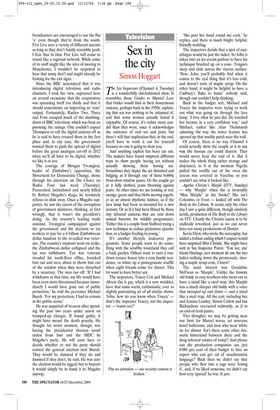Sex in the city
Simon Hoggart
The Sex Inspectors (Channel 4, Tuesday) is a wonderfully old-fashioned show. It resembles those Guides to Married Love that brides would find in their honeymoon suitcase, perhaps back in the 1950s, explaining that sex was nothing to be ashamed of, and that some women actually found it enjoyable. Of course, it’s rather more candid than they were, since it acknowledges the existence of oral sex and porn, but there’s still that implication that, in the end, you’ll have to work it out for yourself because no one is going to show you.
And anything explicit has been cut out. The makers have found umpteen different ways to show people having sex without actually showing them having sex. Sometimes they depict the act distorted and bulging, as if through one of those bobbly front-door window panes. Or the couple go at it fully clothed, jeans thrusting against jeans. At other times we are looking at red, orange, green and blue blobs moving together in an almost rhythmic fashion, as if the lava lamp had been re-invented for a new century. Or as if it had been filmed by those tiny infrared cameras that are sent down animal burrows for wildlife programmes. ‘Either this is a couple from Stafford trying a new technique to reduce premature ejaculation, or a badger feeding its young.’ It’s another lifestyle makeover programme. Some people want to do something with the scrubby wasteland they call a back garden. Others want to turn a rundown terrace house into a cosy family residence, or whizz up a pomegranate soufflé when eight friends come for dinner. This lot want to have better sex.
The inspectors, Tracey Cox and Michael Alvear (he is gay, which is a new wrinkle), have that same warm, enthusiastic, ever so slightly patronising air of all similar shows. ‘John, how do you know when Tracey’ — that’s the inspectee Tracey, not the inspector — ‘wants sex?’ ‘She puts her hand round me cock,’ he replies, and there is much bright, helpful, friendly nodding.
The inspectors decide that a spot of cunnilingus would be just the ticket. So John is taken into an ice-cream parlour to have his technique brushed up on a cone. Tongues slurp and slide across the viscous surface. ‘Now, John, you’ll probably find when it comes to the real thing that it’s less cold, and doesn’t taste of maple syrup. On the other hand, it might be helpful to have a Cadbury’s flake to hand,’ nobody said, though one couldn’t help thinking.
Back in the badger sett, Michael and Tracey the inspector were trying to work out what was going on through the lava lamp. ‘I love what he just did. He touched her breasts in a very confident way,’ said Michael, rather like Alan Titchmarsh admiring the way the water feature has opened up that muddy patch near the wall.
Of course, there is no way Channel 4 could actually show the couple at it in any way the human eye could discern. They would never hear the end of it. But it makes the whole thing rather strange and disjointed, as if at the moment Nigella pulled the soufflé out of the oven the screen was covered in Vaseline so you couldn’t see what it looked like.
Agatha Christie’s Marple (ITV, Sunday) — why ‘Marple’ when she is invariably ‘Miss Marple’ in the books? She isn’t Colombo, or Frost — kicked off with The Body in the Library. It seems only the other day I saw a quite different, though similarly lavish, production of The Body in the Library on ITV. Clearly the Christie canon is to be endlessly reworked, just as we can never have too many productions of Hamlet.
Kevin Elyot, who wrote the screenplay, has added a lesbian ending which I suspect would have surprised Miss Christie. She might have sent in Sex Inspector Poirot. ‘You see, ma’ friend Hastings, zerr moment ah saw the two ladies walking down the promenade, sharing a maple syrup cone, I knew!’ The main interest was Geraldine McEwan as ‘Marple’. Unlike the frowsty old biddy in cosy woollens who turns out to have a mind like a steel trap, this Marple was a much sharper old biddy with a voice that swooped up and down — and a mind like a steel trap. All the cast, including her and Joanna Lumley, Simon Callow and Ian Richardson, overacted stalwartly, as if in an end-of-term panto.
Two thoughts: we may be getting near our limit for Marcel waves, art nouveau hotel ballrooms, and men who wear white tie for dinner. Isn’t there some other dramatic hinterland between there and the drug-infested estates of today? And please can the production companies use just 0.001 per cent of their budget to hire an expert who can get rid of anachronistic language? Back then we didn’t say that people who flew into a rage were ‘losing it’, and, if we liked someone, we didn’t say how very ‘special’ he was. It jars.

















































































 Previous page
Previous page